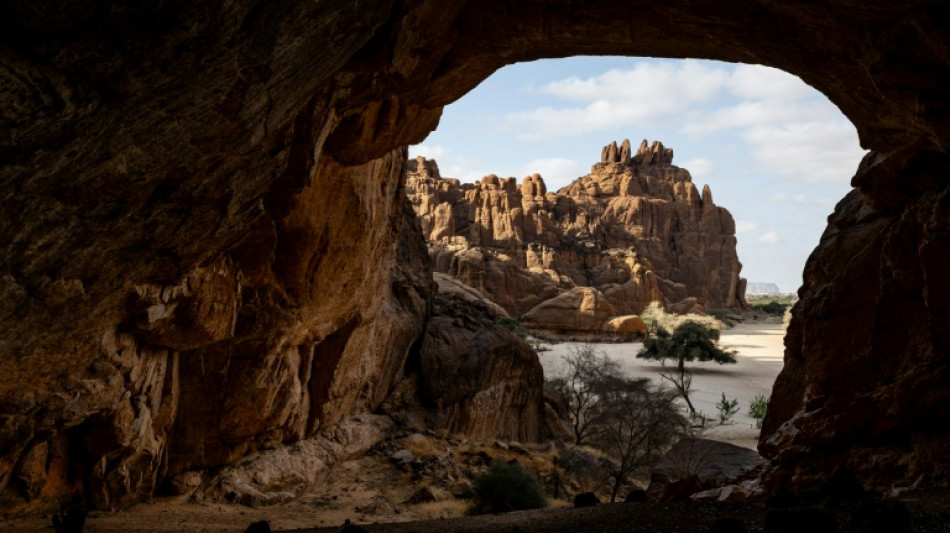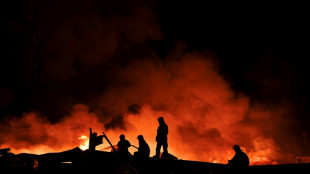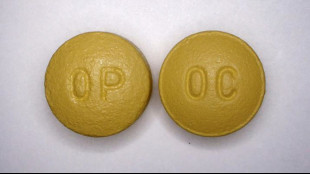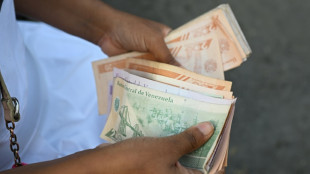
-
 Brazilian 'Superman' cheers child cancer patients in Ghana
Brazilian 'Superman' cheers child cancer patients in Ghana
-
India close in on win over South Africa after Jadeja heroics

-
 Huge explosions rock industrial area near Argentina's capital
Huge explosions rock industrial area near Argentina's capital
-
Bezzecchi takes pole for Valencia sprint and MotoGP

-
 Dominant Shiffrin leads after first slalom run in Levi
Dominant Shiffrin leads after first slalom run in Levi
-
Nine killed in accidental explosion at Indian Kashmir police station

-
 Climate protesters to rally at COP30's halfway mark
Climate protesters to rally at COP30's halfway mark
-
Fighting South Africa lose Rickelton after India 189 all out

-
 Harmer leads South Africa fightback as India 189 all out
Harmer leads South Africa fightback as India 189 all out
-
Prison looms for Brazil's Bolsonaro after court rejects his appeal

-
 EU bows to pressure on loosening AI, privacy rules
EU bows to pressure on loosening AI, privacy rules
-
India close in on lead despite South African strikes

-
 Curry's 49 points propel Warriors in 109-108 win over Spurs
Curry's 49 points propel Warriors in 109-108 win over Spurs
-
NZ boxer Parker denies taking banned substance after failed test

-
 Australia setback as Hazlewood ruled out of 1st Ashes Test
Australia setback as Hazlewood ruled out of 1st Ashes Test
-
Australia pace spearhead Josh Hazlewood ruled out of 1st Ashes Test

-
 UN Security Council to vote Monday on Trump Gaza plan
UN Security Council to vote Monday on Trump Gaza plan
-
Japan's Tomono leads after men's short program at Skate America

-
 China tells citizens to avoid Japan travel as Taiwan row grows
China tells citizens to avoid Japan travel as Taiwan row grows
-
Purdue Pharma to be dissolved as US judge says to approve bankruptcy

-
 Iran's first woman orchestra conductor inspires
Iran's first woman orchestra conductor inspires
-
Wood gets all-clear in boost for England

-
 Golf's world No. 8 Thomas has back surgery
Golf's world No. 8 Thomas has back surgery
-
Rebooted Harlem museum celebrates rise of Black art

-
 'Desperation in the air': immigrant comics skewer Trump crackdown
'Desperation in the air': immigrant comics skewer Trump crackdown
-
UN regulator says shipping still wants to decarbonize -- despite US threats

-
 Grant, Kim share halfway lead in LPGA Annika tournament
Grant, Kim share halfway lead in LPGA Annika tournament
-
Musk's Grokipedia leans on 'questionable' sources, study says

-
 Trump signs order to lower tariffs on beef, coffee, other goods
Trump signs order to lower tariffs on beef, coffee, other goods
-
Croatia qualify for 2026 World Cup, Netherlands close, Germany in limbo

-
 'Last Chance U' coach dies after shooting: US police
'Last Chance U' coach dies after shooting: US police
-
Sinner completes perfect ATP Finals group stage, Auger-Aliassime reaches last four

-
 Woltemade sends Germany past Luxembourg in World Cup qualifier
Woltemade sends Germany past Luxembourg in World Cup qualifier
-
Croatia qualify for 2026 World Cup with 3-1 win over Faroes

-
 Kai Trump makes strides but still misses cut in LPGA debut
Kai Trump makes strides but still misses cut in LPGA debut
-
Return to bad days of hyperinflation looms in Venezuela

-
 US airspace recovers as budget shutdown ends
US airspace recovers as budget shutdown ends
-
Russia strike on Kyiv apartment block kills six, Ukraine says

-
 Arrest made in shooting of 'Last Chance U' coach: US police
Arrest made in shooting of 'Last Chance U' coach: US police
-
At COP30, senator warns US 'deliberately losing' clean tech race with China

-
 US, Switzerland say deal reached on trade and tariffs
US, Switzerland say deal reached on trade and tariffs
-
Fossil fuel lobbyists out in force at Amazon climate talks: NGOs

-
 Returning Alldritt blames himself for France axing
Returning Alldritt blames himself for France axing
-
Stocks struggle on US rates, tech rally fears

-
 A rare oil CEO shows up at COP30, spars with activists
A rare oil CEO shows up at COP30, spars with activists
-
Trump demands probe into Epstein links to Bill Clinton

-
 England great Anderson says 'weak' Australia still Ashes favourites
England great Anderson says 'weak' Australia still Ashes favourites
-
Indigenous protesters disrupt UN climate summit again

-
 Gun salutes for King Charles III as he marks 77th birthday
Gun salutes for King Charles III as he marks 77th birthday
-
Ford urges England to make their own New Zealand history


Tracing the 'Green Sahara' in Chad's northern desert
A cloud of dust escapes from an excavation site in the sand of Chad's arid north, where scientists are looking for signs of human habitation in an area once humid and called the "Green Sahara".
Kneeling, armed with a brush and trowel inside the largest rock shelter at the Gaora Hallagana site in the Ennedi West province, Djimet Guemona, 35, meticulously removed every layer of sand.
"It's as if we are turning the pages of a historic book to travel back in time," said Guemona, an archaeologist at the National Centre for Research and Development.
His face lit up at the discovery of each fragment of pottery or scrap of charcoal.
The scientific mission, conducted over five days in late July some 30 kilometres (nearly 19 miles) from Fada, the main town in Ennedi West, brought together Chadian archaeologists and geologists from universities in N'Djamena and Abeche.
It aimed to lay "the first cornerstone" of the chronological framework for ancient settlements in Ennedi, Guemona said.
The Natural and Cultural Reserve of Ennedi (RNCE) was created in 2018 in the Chadian province, which stands at the crossroads with Libya and Sudan and is home to a rich archaeological heritage.
Tens of thousands of engravings and paintings can be found on the rocky walls across the vast reserve's more than 50,000 square kilometres (19,305 square miles).
Since the RNCE was included on the UNESCO World Heritage list in 2016, the Chadian government brought in the South African organisation, African Parks, to help run it for 15 years.
The head of the scientific mission funded by the group, Mahamat Ahmat Oumar, said 1,686 sites had been catalogued so far.
"But this likely represents less than a quarter of the total," he said.
"There is enormous archaeological potential but it remains poorly documented," Oumar added. "Research has been dominated by foreign scientists.
"Chadian researchers have not sufficiently invested in this part of the country."
- Tourism -
Some sandstone rock formations, tinted pink, purple or orange depending on the time of day, are hard to access.
Even venturing onto the imposing blocks, which look like they have been placed on top of the sand, is a physical and logistical challenge in a province scorched by the sun.
Certain areas have also long been inaccessible due to the border region's tumultuous history.
"There was a break in scientific exploration in the 1960s with the civil war until the 1990s," said Oumar.
Remnants of shells and tank debris from the Chad-Libya war of 1978 to 1987 are still present and travel to the area remains "strongly discouraged" by the foreign ministry of the former colonial power France.
"It's Lascaux times 100,000," joked Frederique Duquesnoy, 61, an archaeologist and associate member of the Mediterranean Laboratory of Prehistoric Europe and Africa (LAMPEA), referring to the network of caves in southwest France famous for its ancient wall art.
Using a phone and a tablet, she employs an image enhancement tool to reveal paintings invisible to the naked eye.
"This herd of domestic cattle reflects a period when there were pastures, gallery forests and waterways here," she said, pointing to a sandy stretch in front of the cave.
"It corresponds to the so-called 'Green Sahara' period" between 10,000 and 3,000 years BC, she added.
Further evidence of the humid era are the depictions of hippopotamuses, giraffes and elephants found in other rock shelters.
Fragments of pottery collected by Celestin Gabi, a 35-year-old Chadian doctoral student in archaeology at France's University of Toulouse Jean Jaures, seem to support the hypothesis.
Some, adorned with wavy patterns, "could date back to 7,000 BC", he said.
- Understanding -
After surveys and potential carbon-dating of the collected materials, the next step will be to organise large-scale digs to deepen understanding of the people who lived in Ennedi during the Early Holocene period and how they adapted to increasingly dry conditions.
"Better understanding this heritage will allow us equally to showcase it to the public and to attract a large number of visitors each year," said Oumar.
"At the moment, only a handful of travel agencies share a market catering to wealthy tourists."
The Chadian authorities are currently drafting a tourist development plan and African Parks hopes it will be finalised by the first half of next year.
"The only way of self-funding the preservation of this heritage is tourism," said Hamid Kodi, 28, the deputy director of RNCE.
African Parks is the second biggest employer in the province after the state, with 149 staff.
The NGO, which oversees around 20 parks across Africa, has previously faced accusations of "neo-colonialist practices" and rights violations.
In Ennedi, African Parks promotes a more responsible management and its "support" for local people, in particular by assigning "management to young people in the region", Kodi, who himself comes from Ennedi, said.
T.Samara--SF-PST


